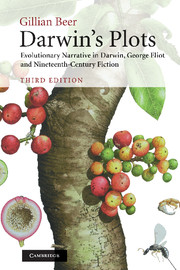Book contents
- Frontmatter
- Contents
- Foreword by George Levine
- Preface to the first edition
- Preface to the second edition
- Preface to the third edition
- Introduction
- Part I Darwin's language
- Part II Darwin's plots
- Part III Responses: George Eliot and Thomas Hardy
- 5 George Eliot: Middlemarch
- 6 George Eliot: Daniel Deronda and the idea of a future life
- 7 Descent and sexual selection: women in narrative
- 8 Finding a scale for the human: plot and writing in Hardy's novels
- 9 Darwin and the consciousness of others
- Notes
- Select bibliography of primary works
- Further reading related to Charles Darwin
- Index
7 - Descent and sexual selection: women in narrative
Published online by Cambridge University Press: 04 August 2010
- Frontmatter
- Contents
- Foreword by George Levine
- Preface to the first edition
- Preface to the second edition
- Preface to the third edition
- Introduction
- Part I Darwin's language
- Part II Darwin's plots
- Part III Responses: George Eliot and Thomas Hardy
- 5 George Eliot: Middlemarch
- 6 George Eliot: Daniel Deronda and the idea of a future life
- 7 Descent and sexual selection: women in narrative
- 8 Finding a scale for the human: plot and writing in Hardy's novels
- 9 Darwin and the consciousness of others
- Notes
- Select bibliography of primary works
- Further reading related to Charles Darwin
- Index
Summary
During the 1870s and 1880s some of the further implications of evolutionary theory became apparent, particularly the social and psychological implications of Darwin's theories and their bearing on relations between men and women. One crucial and recurrent metaphor in The Origin is the heraldic record of great families: ‘all true classification is genealogical’ (404). Succession and inheritance form the ‘hidden bond’ which knits all nature past and present together, just as succession and inheritance organise society and sustain hegemony. Darwin emphasised the egalitarian potential of succession within the natural order: ‘We have no written pedigrees; we have to make our community of descent by resemblances of any kind’ (408). Variations in nature are not within the control of will; they are random and unwilled and may happen to advantage or disadvantage an individual and his progeny in any particular environment.
But in his two major works of the 1870s, The Descent of Man (1871) and The Expression of the Emotions in Man and Animals (1872), Darwin brought humankind openly into the evolutionary debate and emphasised not only natural – that is, unwilled – selection, but also sexual selection. Both the individual will and the internalised values of a community play their part in the processes of sexual selection.
The intersection of evolutionary theory and social, psychological and medical theory therefore became newly important. The bonds between biology and sociology are drawn close in the concept of sexual selection.
- Type
- Chapter
- Information
- Darwin's PlotsEvolutionary Narrative in Darwin, George Eliot and Nineteenth-Century Fiction, pp. 196 - 219Publisher: Cambridge University PressPrint publication year: 2009



